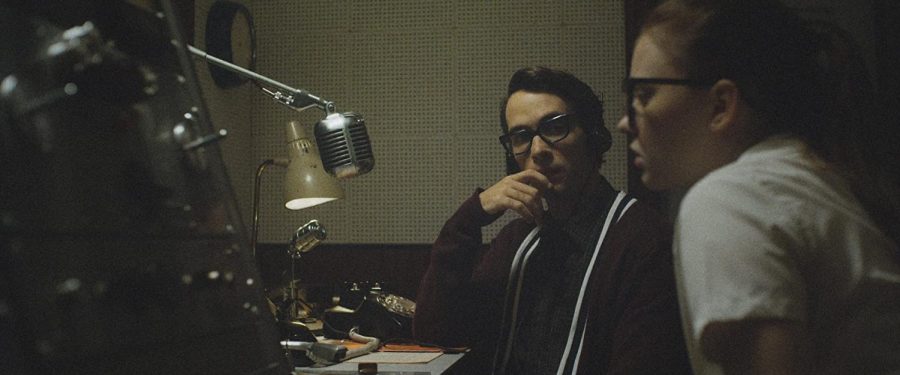Listen closely: ‘The Vast of Night’ is a triumph of character-driven science fiction
May 26, 2020
The camera pulls away from a girl at a switchboard placing a call and begins to speed through the streets of Cayuga, New Mexico. It enters the local high school’s gymnasium before leaving as quickly as it came and slowing to focus on a teenage boy sitting in a radio station. The phone rings.
Via their phone call and this extended, exploratory tracking shot, Andrew Patterson’s “The Vast of Night” connects its two leads.
The film, which premieres this Friday on Amazon Prime, never loses sight of that central pair, budding radio DJ Everett (Jake Horowitz) and novice switchboard operator Fay (Sierra McCormick), even as its sci-fi trappings overtake the personal goings-on of the characters during their investigation of a strange sound of unknown origin that interrupts the local radio signal.
In the opening scene, the film presents itself not as a 21st-century flick, but as an episode of a “Twilight Zone” style sci-fi anthology show called “Paradox Theatre,” playing on a steadily flickering Eisenhower-era black-and-white television.
The camera then zooms into the mega-tracking shot that opens the film, following Everett around the gymnasium during the high school basketball game that continues throughout the entire plot. These extremely long takes are evidently a favorite trick of Patterson’s. He manages to tread safely on ground that can easily slip out from under a director and pull it off.
The tight confines in which “The Vast of Night” operates –– a hazy, distinctly and intentionally low-budget look, a script that essentially limits real characterization to Everett and Fay and a lean 89-minute runtime –– only heighten the frequent moments of real heart and legitimately interesting experimentation.
The script, penned by James Montague and Craig Sanger, is smart and choppy, giving Horowitz about 47 words to say per second, which he gleefully does with a lovely twang and an absolute confidence, never betraying that this is his debut feature.
Communication is the key to the heart of “The Vast of Night.” Telephone lines, radio waves, human conversation and bizarre otherworldly signals cross over and surround each other, confusing matters even as they get clearer. That signature tracking shot links Fay, frantically connecting people to each other through her switchboard, and Everett, going out over the airwaves to, by his own admission, “five people.” For Patterson, it’s all about communication, when it works and when it fails –– Fay has to cope with phone lines cutting out constantly at key plot junctures.
It’s no surprise, then, that the sci-fi angle works its way in via what might just be extraterrestrial communication, a bizarre sound that interrupts Everett’s radio show and Fay’s telephone call at the same time. Baffled, they put out a call for anyone who can identify the sound to phone in to the radio show, prompting a call from a man calling himself “Billy,” a black ex-soldier whose phone unsurprisingly has some connectivity issues.
Their conversation with Billy sends them stumbling and sprinting through Cayuga, meeting up with –– among others –– a wandering couple, Fay’s baby sister and a mysterious old woman (Gail Cronauer) who claims her son had an extraterrestrial encounter many years ago. All along, they’re either talking into Fay’s portable tape recorder, pulling a phone line as far as it’ll go from the building it belongs to or broadcasting live to all of the town.
Everything is in constant communication with everything else, decades before the Internet. The elderly woman says that her tale is a “a companion story” to Billy’s, in conversation with it but not necessarily perfectly aligned — take it or leave it. Everett initially leaves it, but it comes back around anyway.
Patterson is unafraid to reject convention for his purposes. As Billy, a disembodied voice coming through the phone and going out over the radio, tells his unsettling story, the screen fades to black for minutes at a time. Multiple scenes open or close on an abrupt switch back to the visual of the TV from the introduction, smushed to the center of the screen and slathered in grain. As the film progresses further and further from its initial grounding in something resembling the world we know, the long takes fizzle out, replaced by rapid editing in the closing sequence, cutting frequently and abruptly between faces and locations to chilling effect.
It’s a triumphant progression, executed steadily and without sacrificing emotional impact. Aside from the look, which works to the movie’s advantage, you’d never think this was a either a debut or early-career feature for many of its makers and performers. It’s bold enough to let a voiceover on a black screen carry significant screen time, it’s steady in its numerous long shots and it’s solid in its thematic concerns.
Something is in the sky, attempting to communicate with us, and we as humans are attempting to communicate with each other –– but is any of it stable enough to matter? “The Vast of Night” isn’t entirely sure, but it’s winning enough and daring enough to explore without compromise and provide a hell of a ride in the process.



